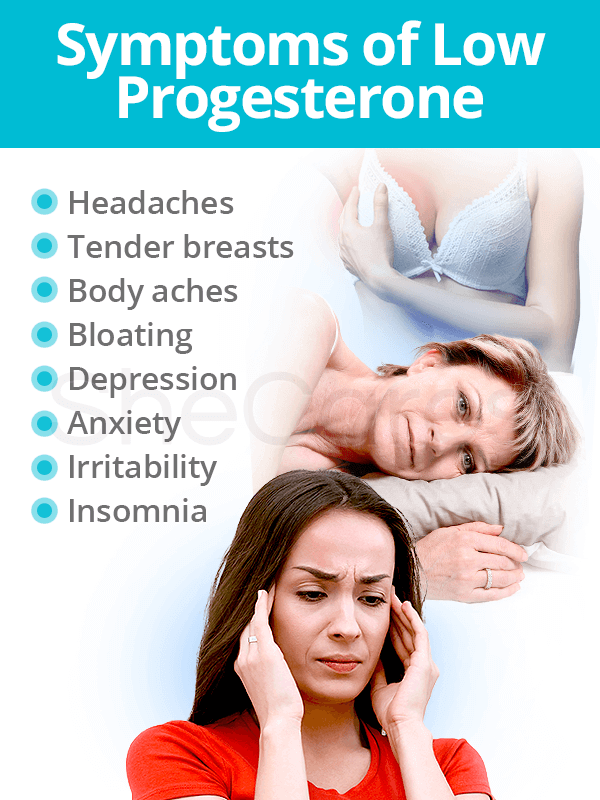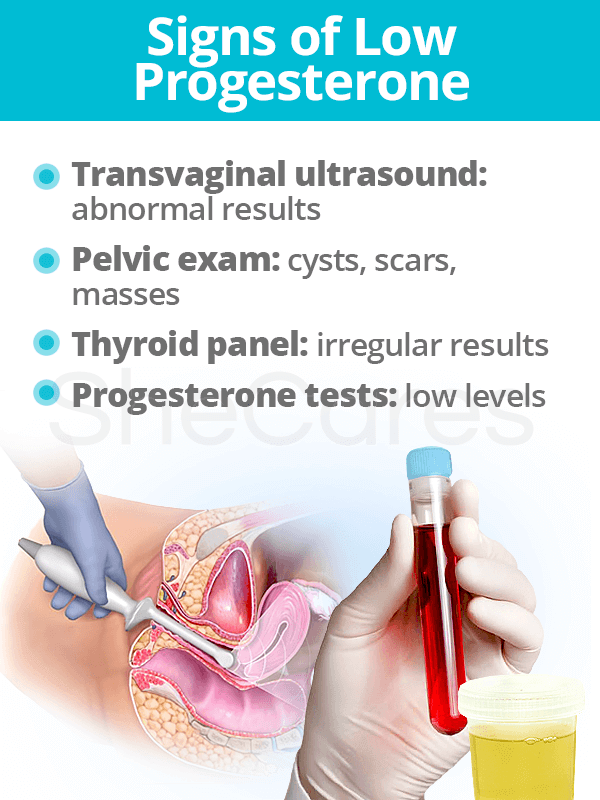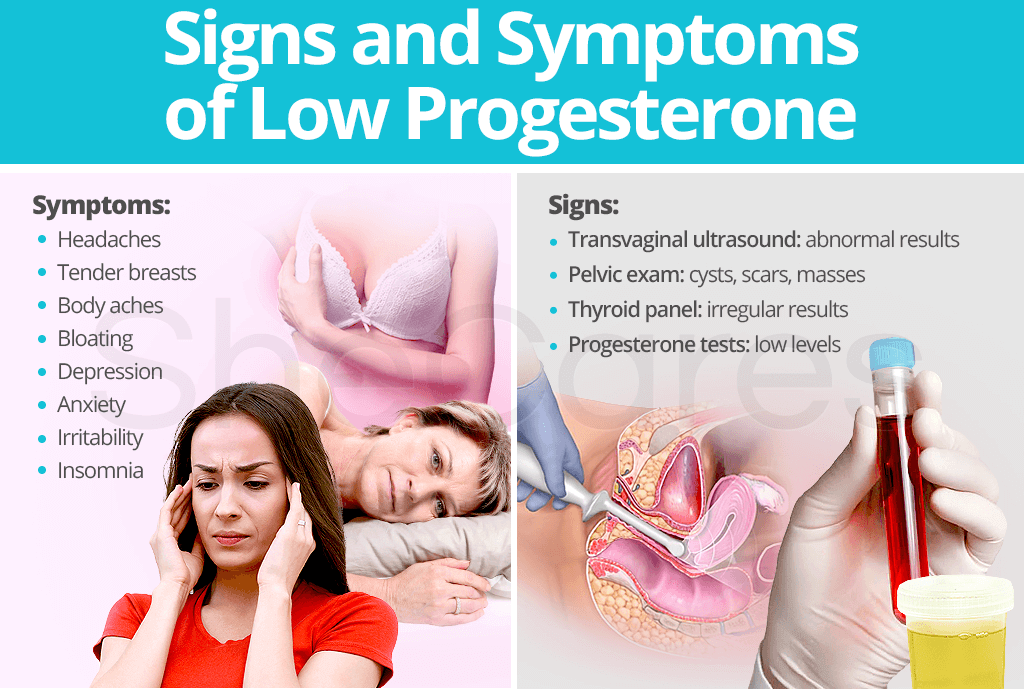It is not uncommon for signs and symptoms of low progesterone to accumulate and worsen into irreversible conditions as they are continually attributed to incorrect underlying causes.
In order to avoid a potential dreadful downward spiral and get health back on track, continue reading to learn more about the signs and symptoms of low progesterone levels.
Symptoms of Low Progesterone Levels
Low progesterone symptoms - many of which are listed below - can occur throughout life and affect more than just the female reproductive system.
Physical Symptoms

- Headaches and migraines
- Hot flashes
- Cystic or tender breasts
- Weight gain
- Nausea
- Loss of libido
- Increased heart rate
- Body aches
- Bloating
- Thinning hair
- Absent or irregular periods
- Increased PMS symptoms
Psychological Symptoms
- Depression
- Anxiety
- Memory lapses
- Low self-esteem
Signs of Low Progesterone Levels
Medical signs are results doctors use as evidence to diagnose a hormonal imbalance. Many of these signs women may not associate with low progesterone levels.
Together with symptoms, these medical signs and indications can help a physician correctly detect the shortage of progesterone in the body.

Abnormal x-ray, transvaginal ultrasound, laparoscopy, or MRI results
Pelvic or abdominal examination showing presence of atypical cysts, scars, or pelvic masses
Blood tests showing abnormal serotonin, TSH, T3, or T4 levels
Abnormal patterns in levels of the pregnancy hormone hCG (forewarning of a miscarriage)
- Progesterone tests
(blood, urine, or saliva) showing low progesterone levels
Accordingly, when low progesterone side effects are detected sooner rather than later, hormonal levels can be normalized before further complications arise. More serious conditions may develop from a progesterone deficiency if the imbalance continues.
Continue reading to learn more about a couple life-threatening concerns caused by constantly low progesterone levels.
Endometrial Cancer and Low Progesterone
Endometrial cancer is the fourth most common disease in women and is predominantly a hormone-driven form of cancer. Research studies state that approximately 80 percent of endometrial cancers arise in the wake of excess estrogen or a lack of progesterone.1
In a healthy endometrium, estrogen's growth effects are normally counteracted by progesterone. Estrogen encourages proliferation of the endometrial lining during the follicular phase of the menstrual cycle, and during the luteal phase, progesterone takes over to disturb growth and promote differentiation of the cells.
However, the absence of progesterone induces carcinogenesis, in which healthy cells are changed into cancer cells. An estrogen dominant state only amplifies the cancer's formation.
Breast Cancer and Low Progesterone
Breast cancer risk is increased by endogenous estrogen hormones unopposed by progesterone. In other words, women who are at risk of breast cancer often exhibit low progesterone levels in the presence of high estrogen.
Research has found that progesterone inhibits the proliferation of several lines of human breast cancer cells that are progesterone receptor (PR) positive, but not PR negative. The opposite is true of the estrogen hormone estradiol, which stimulates the growth of estrogen receptor (ER) positive breast cancer cells.2
Furthermore, progesterone enhances functions of tumor-suppressive genes while diminishing those of the tumor-promoting genes. This leads to increased “apoptosis,” the programmed suicide of breast cancer cells.
Continue reading to learn more about increasing progesterone levels in order to evade the future onset of low progesterone-related health conditions.
Sources
- Kim, J.J. & Chapman-Davis, E. (2010). Role of Progesterone in Endometrial Cancer. Seminars in Reproductive Medicine, 28(1), 81-90. doi: 10.1055/s-0029-1242998
- Mayo Clinic. (2016). Ovarian cysts: Diagnosis | Endometriosis: Diagnosis | Miscarriage: Diagnosis & Treatment. Retrieved September 30, 2019, from https://www.mayoclinic.org/diseases-conditions/ovarian-cysts/diagnosis-treatment/drc-20353411 | https://www.mayoclinic.org/diseases-conditions/endometriosis/diagnosis-treatment/drc-20354661 | https://www.mayoclinic.org/diseases-conditions/pregnancy-loss-miscarriage/diagnosis-treatment/drc-20354304
- National Women's Health Resource Center. (n.d.). Low Progesterone Symptoms. Retrieved September 30, 2019, from http://www.healthywomen.org/content/article/low-progesterone-symptoms
- Stoll, B.A. (Ed.). (1991). Approaches to Breast Cancer Prevention. UK: Kluwer Academic Publishers. Available from Google Books.
- UCLA Obstetrics and Gynecology. (n.d.). Fibroids. Retrieved September 30, 2019, from http://obgyn.ucla.edu/fibroids
Footnotes:
- Carlson, M.J. et al. (2012). Catch It Before It Kills: Progesterone, Obesity, and the Prevention of Endometrial Cancer. Discovery Medicine, 14(76), 215-222. Retrieved September 30, 2019, from https://www.ncbi.nlm.nih.gov/pmc/articles/PMC3964851/
- Mahmud, K. (2008). Keeping aBreast: Ways to PREVENT Breast Cancer. New York: Strategic Book Publishing. Available from Google Books.


